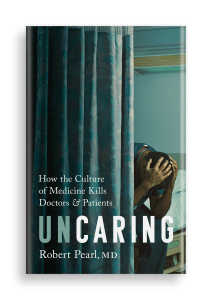The following is an exclusive excerpt from my new book “Uncaring: How the Culture of Medicine Kills Doctors & Patients,” which comes out May 18, 2021 and is available in audio book, ebook and hardcover. All profits from the book go to Doctors Without Borders.
This is a story about a Hungarian physician who makes an incredible discovery—one that undermines the deeply entrenched beliefs and values of his clinical colleagues. In this doctor’s zeal to transform medical practice, he learns a hard lesson and pays a steep price …
starting on page 17 …
Doctors of the twenty-first century point with pride to the incredible innovations and discoveries that have advanced modern medical practice. Magnetic resonance imaging (MRI) machines give physicians an unobstructed view inside the human body, allowing them to diagnose a multitude of conditions, from torn ligaments to malignant tumors.
Heart-lung and ECMO (extracorporeal membrane oxygenation) machines enable doctors to stop and restart the human heart, bypassing the patient’s own cardiopulmonary system completely. Scientists can now sequence the human genome, down to its last nucleic acid, paving the way for ever-more effective cancer treatments.
Despite all this scientific progress, physicians today often fail to fulfill basic clinical expectations. The story of an obstetrician named Dr. Ignaz Semmelweis gives twenty-first-century observers a clear insight into the origins of this strange inertia. Let’s join the German-Hungarian physician at his workplace in nineteenth-century Austria.
* * *
Fresh out of medical school in 1844, Dr. Semmelweis found himself perturbed by the maternal death rate in the obstetrical ward of the Viennese hospital where he worked. He calculated that as many as one in four mothers did not make it out of childbirth alive. He also observed a strange inconsistency: although his unit, run by doctors, had a high but typical mortality rate for the time, the adjacent labor and delivery unit, run by midwives, had a death rate two-thirds lower. Given that his fellow physicians had far more training and much higher occupational prestige than the midwives, Semmelweis was both perplexed and embarrassed by these mortality statistics.
Semmelweis knew these mothers were dying from a devastating uterine infection called puerperal fever, but he could not be sure what was causing it. (Mind you, it would be another fifty years before Louis Pasteur discovered the existence of bacteria and germs.) The accepted theory among Semmelweis’s contemporaries had to do with the existence of miasmas.
According to Europe’s leading scientists at the time, miasmas were nasty little particles in the air that were associated with bad smells. These particles supposedly wafted from the streets and sewers of well-trafficked cities up into hospital rooms, where they were inhaled by mothers, who consequently suffered infection.
Short of burning down hospitals filled with these invisible particles, doctors of the 1800s believed there was nothing physicians could do to avoid or eliminate the problem. But if miasmas were the cause of this fatal fever killing mothers, then why was the mortality rate so much lower in the adjacent obstetrical unit run by midwives?
Preorder ‘Uncaring’ and claim your presale rewards here:

One day, a doctor who worked alongside Semmelweis accidentally nicked his finger while performing an autopsy on a woman who had just died from puerperal fever following childbirth. The doctor, in turn, developed a nasty hand infection and succumbed from an illness that seemed identical to the puerperal fever that had taken the life of his patient. Semmelweis recognized the significance of this occurrence. He postulated that the cause of postpartum uterine infection had nothing to do with tiny stink particles floating through the air. Rather, it had everything to do with the doctors who were performing the deliveries.
He hypothesized that the physicians who marched around the hospital with blood-stained hands and pus-splattered aprons were responsible for transmitting diseases to laboring moms. Based on this theory, Semmelweis ordered physicians in his unit to change their aprons and disinfect their hands by dipping them in a chlorine antiseptic solution before examining new patients. The results were astounding. The maternal death rate in the hospital plummeted from 18.27 percent to 1.27 percent.
In 1861, Semmelweis published his principal work, The Etiology, Concept, and Prophylaxis of Childbed Fever, outlining his research and the steps required to prevent the spread of disease. Knowing the results were indisputable and his findings capable of saving countless lives, he sent the paper to Europe’s most prominent obstetricians and medical societies. He then personally addressed open letters to professors of medicine in other countries around the world, heralding the discovery.
Then he waited. And he waited some more. And nothing happened.
Most doctors ignored Semmelweis’s recommendations. Those who offered comment were openly critical of his theory. For years, his findings were either unheeded or outright rejected by the global community of doctors. Thanks in part to the widespread dismissal of his work, Semmelweis had trouble finding a job, and in 1865 he died alone in a mental institution.
* * *
Nearly one hundred sixty years have passed since Semmelweis’s breakthrough discovery. Medical knowledge, hospital cleanliness, and clinical practice today bear little resemblance to the filthy conditions and unenlightened routines of nineteenth-century Vienna. Doctors now understand the existence of bacteria and the spread of viruses. More than that, they have determined the exact genetic makeup of these submicroscopic organisms and identified their chemical composition down to the cellular membrane. As part of obtaining hospital admitting privileges, physicians must pass tests on hospital-acquired infections, including their origin and prevention. On written exams concerning the importance of handwashing and the dangers of spreading germs, doctors score perfectly.
However, contrary to what most patients assume, there exists a huge gap between what physicians know and what they do. Despite the pinpoint accuracy of the answers they provide on the tests, doctors across the country regularly fail to wash their hands (or use gel-based disinfectants) when going from one patient’s room to the next.
How regularly? According to the published findings of numerous research studies, doctors in US hospitals fail to wash their hands one out of every three times they enter a patient’s room.
As in Semmelweis’s time, the consequences remain dire. Healthcare-acquired (or associated) infections are the fourth-leading cause of death in the United States, affecting 1.7 million Americans each year and killing almost 100,000 of them. The spread of these harmful infections, particularly those caused by the deadly organism Clostridium difficile or C. diff, often results from doctors carrying the bacterium on their unwashed hands when going from one patient’s room to the next.
Though these habits are extremely concerning, perhaps equally concerning is the blasé reaction doctors have to these mortality statistics.
I have sat through dozens of hospital staff meetings where the issue of hand hygiene has been raised by infectious disease experts. The typical response from doctors is indifference. On occasion, when physicians speak up, it is to defend themselves.
“I always wash my hands, except when I don’t plan to touch the patient,” one doctor will say to the agreeable head nodding of others. Or “I make sure to always wear gloves when I enter a patient’s room,” ignoring the fact that bacterium can spread when the gloves are put on and taken off. When the infectious disease experts at these educational sessions explain that handwashing remains vital, the physicians generally say nothing, preferring to disregard them, just like Semmelweis’s colleagues.
How do we reconcile this continuation of poor hand hygiene, now more than a century after miasma theory was discarded and replaced by the germ theory of disease? The answer lies in physician culture—in the shared perceptions that doctors have about themselves and their colleagues. As healers, doctors desire respect and feel they must convey to patients, both verbally and symbolically, that they are consummate professionals and experts who know exactly what they are doing at all times.
In Semmelweis’s time, doctors had a disgusting way of preserving the positive perceptions of patients and showcasing their expertise. Back then it was assumed that the more dried blood and pus caked upon the doctor’s leather apron, the more experience he had and the more respect he deserved. Surely any physician covered in guts must be well-trained and extremely knowledgeable. Therefore the merest suggestion that the doctor’s apron or the physician himself could be spreading disease was medical heresy. Doctors don’t cause illness or harm patients. They heal them. Period.
Looking back, we can conclude that it was naïve and foolish of Semmelweis to assume doctors would simply discard their aprons and forfeit assumptions about their own professional excellence. They saw themselves as highly dedicated doctors, not as potentially contaminated sources of infection. It is no wonder they found Semmelweis’s conclusions absurd and dismissed his recommendations.
Today the filthy leather apron has been replaced with the long white coat, a modern symbol of physician exceptionalism. Those who don it are presumed to be esteemed healers, not purveyors of harm. Implicit in the coat’s color is the enduring cultural belief that physicians are pure, uncontaminated, and incapable of transmitting infectious disease. When a patient dies from a hospital-acquired infection, each treating physician assumes it was someone else’s fault, probably the housekeeping staff or one of the nurses. These denials aren’t scientific or logical. They are cultural.
Make no mistake, there is nothing that keeps doctors from observing proper hand hygiene. Soap, water, and paper towel dispensers are available in every patient’s room. For physicians worried about damaging their skin, there are soothing alcohol-based antibacterial liquids adjacent the sinks. The time required to practice good hygiene, especially with fast-acting disinfectant gels, is less than two seconds. And yet, nearly two hundred years since Semmelweis demonstrated the value of handwashing, US doctors omit this life-saving step one-third of the time. And just as they did then, physicians look the other way when their colleagues do the same.







